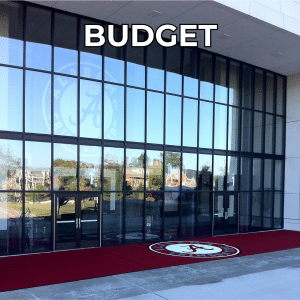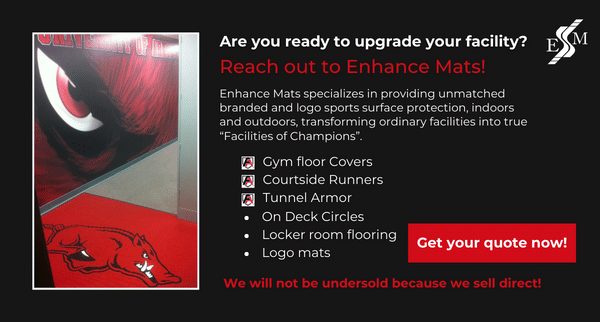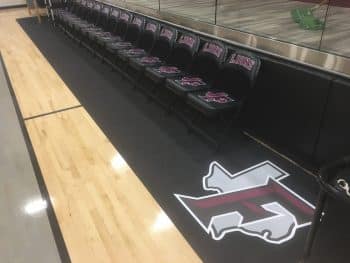‘Mastering the Game’: Navigating the Top 5 Facility Management Challenges in Collegiate Athletics
In the dynamic world of collegiate athletics, coaches grapple with unique facility management challenges that require strategic solutions for success. Check out a good example of how a multifaceted approach was implemented to update an outdated facility, Hayward Field. Then explore the top five pain points that you face as facility managers, athletic directors and college coaches. See how innovative approaches can turn these challenges into opportunities for excellence and your ‘Facility of Champions’!
Case Study: Hayward Field at the University of Oregon
Background: Hayward Field, a historic track and field stadium located at the University of Oregon in Eugene, underwent a significant renovation to become a world-class collegiate athletic facility. The project was initiated to address several facility management challenges, including aging infrastructure, the need for modern technology integration, maintaining athlete and spectator safety, budgetary constraints, and the desire to enhance community and athlete engagement.
Challenges and Solutions:
1. Infrastructure Improvement:
-
- Challenge: The original Hayward Field faced limitations due to its aging facilities, which were not conducive to supporting the performance needs of top-tier athletes or the experience expectations of spectators.
- Solution: The renovation introduced state-of-the-art athlete support areas, including locker rooms, training rooms, and recovery facilities, alongside vastly improved spectator amenities such as increased seating capacity, better sightlines, and modern concession areas.
2. Technological Integration:
Challenge: Keeping pace with the technological demands of modern collegiate athletics, from performance analysis tools to fan engagement platforms.
Solution: The new Hayward Field incorporates cutting-edge technology, including a high-definition video board, advanced timing systems, and integrated performance analysis tools for athletes and coaches.
2. Budget Optimization:
Challenge: Managing the financial aspects of a major renovation project, ensuring funds are allocated efficiently without compromising on quality or necessary features.
Solution: The project was funded through private donations, highlighting the importance of engaging alumni and donors in facility development projects. This approach allowed for high-quality renovations without placing a financial burden on the university or its athletic department.
3. Safety Standards:
Challenge: Ensuring the renovated stadium met the highest safety and accessibility standards for both athletes and spectators.
Solution: The design incorporated the latest in safety standards, including emergency egress routes, barrier-free accessibilities for individuals with disabilities, and state-of-the-art health and wellness facilities for athletes.
4. Community Engagement:
Challenge: Maintaining Hayward Field’s legacy as a community landmark and ensuring the renovation would serve not just the university but also the broader community.
Solution: The new facility was designed with a clear emphasis on community access, including spaces for local events, educational programs, and involvement in promoting track and field among youth.
Outcome:
The renovated Hayward Field has set a new standard for collegiate athletic facilities, successfully addressing the multifaceted challenges of facility management. It serves as an excellent example of how visionary planning, community involvement, and a commitment to excellence can transform collegiate sports facilities into world-class venues.
This case study demonstrates that, despite the complexity of managing college athletic facilities, innovative solutions and strategic partnerships can lead to successful outcomes that benefit athletes, spectators, and the community.
Once your school’s management team has completed a full evaluation of your facility for your collegiate athletics, see the following suggestions that you can put into place to plan, budget and complete the needed and crucial upgrades to improve your facility on all levels.
1.Strategic Investments for Championship Collegiate Athletic Facilities within Budget.
College sports often contend with budget constraints that impact the desired upgrades. Savvy coaches maximize every dollar through strategic investments, prioritizing upgrades, and cultivating community partnerships. With any upgrades to their facilities, it is crucial for the coaches to make informed choices to maintain competitive, functional, and inspiring facilities within budget constraints.
Here are 5 suggestions to improve the quality and appeal of you sport facility while maximizing your budget.
- Leverage Custom Mats with sports logos and Surface Protection: Incorporating custom logo mats not only enhances school spirit but also protects your investment in flooring surfaces. High-quality, durable mats at entrances, in locker rooms, and in high-traffic areas can reduce maintenance costs and showcase your school’s brand. Enhance Mats offers a variety of custom solutions that are perfect for promoting team loyalty while protecting your facility’s floors.
- Implement Energy-Efficient Solutions: Upgrading to energy-efficient lighting and HVAC systems can significantly reduce long-term operating costs. LED lighting, for example, not only improves the quality of light in your facility but also consumes less energy and has a longer lifespan than traditional lighting systems. These upgrades can result in substantial savings on utility bills, freeing up more of your budget for other projects.
- Seek Out Sponsorships and Partnerships: Collaborating with local businesses and alumni can open up new funding opportunities for facility upgrades. Offering sponsorship spaces within your facility, such as naming rights to certain areas or advertising spaces on custom logo mats and digital scoreboards, can generate additional revenue. These partnerships not only support your facility’s upgrades but also strengthen community ties.
- Prioritize Multi-Use Spaces: When planning upgrades, focus on versatility. Facilities that can host multiple sports or events can maximize usage and generate more income. For example, an indoor practice field with a durable, protective floor covering can serve various sports teams throughout the year, hosting everything from practice sessions to community events, thereby increasing its value and utility.
- Invest in High-Impact, Low-Cost Upgrades: Sometimes, small changes can make a big difference in the appearance and functionality of your facilities. Fresh paint, new locker room benches, updated signage, and vibrant, custom logo mats can dramatically improve the aesthetic appeal of your facilities without a huge investment. These upgrades can boost morale among athletes and coaches and make a strong impression on recruits and visitors.
By adopting these strategies, facility managers and athletic directors can stretch their budgets further while creating an environment that fosters pride, performance, and community spirit. Enhance Mats is committed to helping schools achieve these goals by providing high-quality, customizable solutions that reflect the spirit and excellence of your athletic programs.
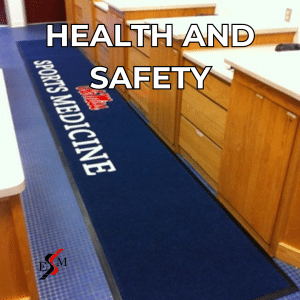
2. Safety-Driven Success: Meeting Health Regulations for Winning Teams in Collegiate Athletics
Athlete safety is paramount in collegiate sports. Coaches play a critical role in exceeding health and safety regulations, creating an environment where athletes can perform with confidence. The safest sports facilities often translate to the most successful ones in the competitive landscape, and it is important to develop a culture that will influence performance.
Here are five suggestions for facility managers and athletic directors to create a safety-driven environment that meets and exceeds health regulations:
- Implement Comprehensive Health Screenings and Monitoring: Regular health screenings, including cardiac assessments and concussion baseline testing, are crucial for early detection of potential health issues. Implementing continuous health monitoring through wearable technology can also track athletes’ vital signs and fatigue levels, allowing for timely interventions. Establishing a robust health screening and monitoring program ensures that athletes are fit for play and that any health concerns are addressed proactively.
- Adopt Advanced Cleaning and Sanitization Protocols: In the wake of global health challenges, maintaining a clean and safe environment has never been more important. Facility managers should invest in advanced cleaning technologies, such as electrostatic sprayers for uniform disinfection, and uphold strict sanitization protocols, especially in high-contact areas like locker rooms, weight rooms, and equipment. Regularly updated protocols based on the latest health guidelines can prevent the spread of infectious diseases and provide a safe training environment.
- Enhance Emergency Preparedness and Response Plans: Comprehensive emergency action plans (EAPs) tailored to various scenarios, including severe injuries, health crises, and natural disasters, are essential. Regular training and drills for coaching staff, athletes, and facility personnel ensure that everyone knows their role in an emergency, significantly improving the response to and management of incidents. Investing in defibrillators (AEDs), emergency communication systems, and first aid stations throughout the facility are key components of a prepared and safe sports environment.
- Provide Mental Health Support and Resources: Athlete safety extends beyond the physical to include mental health and well-being. Creating access to sports psychologists and mental health professionals, offering workshops on stress management, and fostering an environment where athletes feel comfortable seeking help are crucial. Mental health support helps athletes cope with the pressures of competition and academia, contributing to their overall safety and success.
- Regularly Review and Update Safety Policies and Training Programs: Safety protocols and training programs should not remain static. Regular reviews and updates in line with the latest research, technological advancements, and regulatory changes ensure that safety measures are effective and comprehensive. Engaging with health and safety experts, attending workshops, and incorporating feedback from athletes can help identify areas for improvement, ensuring that the program evolves to meet current and future needs.
For facility managers and athletic directors, embracing these technologies represents an investment in the future success of their athletes and programs. By staying informed about and integrating these advancements, collegiate athletic programs can provide their athletes with the tools necessary to achieve their full potential, fostering an environment of excellence and innovation.
3. Cutting-Edge Training Technologies: Elevating Athlete Performance in Collegiate Athletics
Staying ahead in collegiate athletics requires integrating the latest training technologies. From wearable tech to virtual reality and analytics platforms, coaches face the challenge of adopting and seamlessly integrating these tools. Coaches will need to be at the forefront of leveraging technology to make data-driven decisions that propel athletes to peak performance.
Check out these 5 suggestions to keep your facility in the lead with training technology:
- Incorporate Wearable Technology: Wearable tech, such as GPS vests, heart rate monitors, and smart clothing, offers real-time data on athlete performance, health, and fatigue levels. These devices enable coaches to tailor training programs to the individual needs of each athlete, optimize performance, and prevent injuries by monitoring workload and recovery. Investing in wearable technology can provide precise insights that lead to more personalized and effective training regimens.
- Utilize Video Analysis and Motion Capture Systems: Advanced video analysis and motion capture technologies can break down athletes’ movements in intricate detail, offering insights into technique that were previously unattainable. These systems help in identifying areas for improvement, enhancing technique, and reducing injury risks. By incorporating these tools into training facilities, coaches can offer immediate feedback and detailed analysis, fostering a culture of continuous improvement and precision in training.
- Implement Virtual Reality (VR) Training Programs: VR technology offers a unique way to simulate real-game situations and environments without the physical wear and tear of actual gameplay. It can be particularly useful for mental rehearsal, strategy training, and decision-making practice. VR can also provide a safe environment for rehabilitating athletes to practice without the risk of re-injury. Incorporating VR into training facilities allows athletes to gain valuable repetitions and experience in a controlled, immersive environment.
- Adopt Advanced Analytics and Performance Platforms: Data analytics platforms that aggregate data from various sources (wearable tech, video analysis, etc.) provide comprehensive insights into athlete performance and team dynamics. These platforms can help in identifying patterns, predicting outcomes, and making informed decisions on training, strategy, and recovery. By leveraging data analytics, coaches can enhance their decision-making process with evidence-based strategies that are tailored to the strengths and weaknesses of their team.
- Explore Recovery and Rehabilitation Technologies: Cutting-edge technologies in recovery and rehabilitation, such as cryotherapy chambers, pneumatic compression devices, and electric muscle stimulators, can significantly reduce recovery time and improve athlete well-being. Investing in these technologies ensures athletes return to peak condition faster, with reduced risk of injury recurrence. By prioritizing recovery, facilities can maintain athlete performance at the highest level throughout the season.
By prioritizing these areas, facility managers and athletic directors can create a culture of safety that not only meets but exceeds health regulations, providing athletes with the confidence to perform at their best. A commitment to safety is a commitment to the success and longevity of collegiate sports programs, underlining the importance of a proactive and comprehensive approach to athlete health and safety.
4. Striking the Balance: Dual Excellence in Academics and Athletics
Student-athletes navigate a delicate balancing act between academics and training. Coaches guide them toward success in both areas by fostering flexible training schedules, providing academic support, and emphasizing a culture that values education alongside athletic performance. These dual forces will help prepare students for success beyond college sports.
Here are five valuable suggestions for facility managers and athletic directors aiming to support student-athletes in this balancing act:
- Establish Academic Support Systems: Create dedicated study spaces within athletic facilities and provide access to academic tutors specialized in working with athletes. Implementing a comprehensive academic support system, including mentorship programs where older student-athletes guide younger ones, helps ensure that athletes receive the assistance they need to excel in their studies. This infrastructure demonstrates a commitment to the academic success of student-athletes, reinforcing the message that education is a priority.
- Integrate Flexible Training Schedules: Recognize the academic demands on student-athletes by offering flexible training schedules. This might include varying practice times, accommodating important academic deadlines, and providing options for off-season training. By allowing athletes to balance their coursework and athletic commitments effectively, coaches and administrators support their pursuit of excellence in both arenas.
- Promote a Culture of Academic Achievement: Cultivate an environment that celebrates academic achievements alongside athletic accomplishments. Recognizing academic successes in team meetings, on social media, and at sports events underscores the importance of educational attainment. Encouraging athletes to pursue internships and engage in community service also enriches their college experience, preparing them for life after sports.
- Leverage Technology for Time Management: Provide student-athletes with access to time management and organizational tools, such as apps and software, to help them manage their schedules effectively. Workshops on time management, study skills, and stress management can equip athletes with the strategies they need to navigate their dual commitments successfully.
- Ensure Open Communication Channels: Maintain open lines of communication between athletic departments, academic advisors, and faculty to monitor student-athletes’ academic progress and address any issues proactively. This collaborative approach ensures that athletes receive the support they need and that any potential conflicts between academic and athletic commitments are resolved efficiently.
By implementing these strategies, facility managers and athletic directors can foster an environment that supports student-athletes in achieving excellence in both academics and athletics. This holistic approach not only enhances the collegiate experience for student-athletes but also prepares them for successful careers and fulfilling lives beyond the realm of competitive sports.
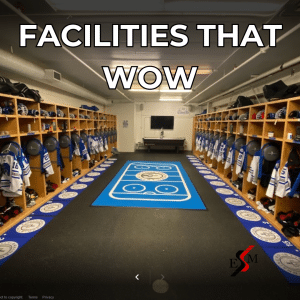
5. Collegiate Facilities That Wow: The Ultimate Talent Magnet
Recruiting is key and in the competitive world of collegiate athletics, top-notch sports facilities act as the ultimate talent magnet. Offering the best training environments to attract and retain elite athletes needs to include the latest in sports science, nutrition, recovery, and training.
Here are five key suggestions for facility managers and athletic directors to create environments that not only wow prospects but also significantly contribute to their development and success:
- Incorporate Cutting-Edge Training Equipment and Technology: Equip your facilities with the latest training and performance analysis tools, including advanced strength and conditioning equipment, wearable technology for real-time performance tracking, and video analysis systems. Offering access to the latest in sports science technology not only enhances training outcomes but also demonstrates a commitment to athlete development, making your program more attractive to prospective recruits.
- Design Specialized Training and Recovery Areas: Develop dedicated spaces for both sport-specific training and general athletic development. Include areas for recovery, such as hydrotherapy pools, cryotherapy chambers, and sleep pods, to emphasize the importance of rest and recovery in athlete performance. Creating environments that cater to all aspects of an athlete’s development and well-being shows a holistic approach to their growth and is a significant draw for recruits.
- Offer Comprehensive Nutrition and Wellness Programs: Integrate a sports nutrition program complete with dietitian consultations, personalized meal plans, and cooking classes to educate athletes on fueling their bodies for optimal performance. Facilities should also house or provide easy access to healthy dining options that cater to the diverse needs and preferences of athletes. This commitment to nutrition and wellness is a critical factor in attracting health-conscious recruits.
- Ensure Versatile and Multi-Use Spaces: Design facilities that can adapt to various sports and activities, allowing for year-round training opportunities regardless of weather conditions. Versatile indoor and outdoor training spaces, including synthetic turf fields and indoor tracks, ensure that athletes have the resources to train effectively in any season. This flexibility not only maximizes facility usage but also appeals to athletes from a broad range of sports.
- Foster a Strong Community and Support Network: Beyond the physical aspects of the facilities, create an environment that promotes a sense of belonging and support. This can include spaces designed to encourage team bonding, collaboration, and relaxation, as well as access to mental health resources and academic support services. A strong community culture within your athletic facilities can significantly impact a recruit’s decision, as it reflects a supportive and holistic approach to their collegiate athletics experience.
By focusing on these key areas, collegiate programs can create facilities that not only impress recruits but also provide them with the tools and support necessary for their development as athletes and individuals. These facilities become more than just places to train; they symbolize a program’s investment in the holistic success of its athletes, making them powerful magnets for recruiting top talent.
Achieving success in collegiate athletics involves mastering facility management challenges. By addressing these challenges and embracing innovative solutions, coaches can create an environment where athletes thrive, and championship aspirations become a reality.
Enhance Mat’s experienced team is a tremendous asset in assisting Coaches, Athletic Directors and Facility Managers Brand and Protect their facilities, helping to create the optimum environment to recruit and develop their athletes. With over 15 years of on the ground experience, our team is available to help with any of your projects, indoors and outdoors.


